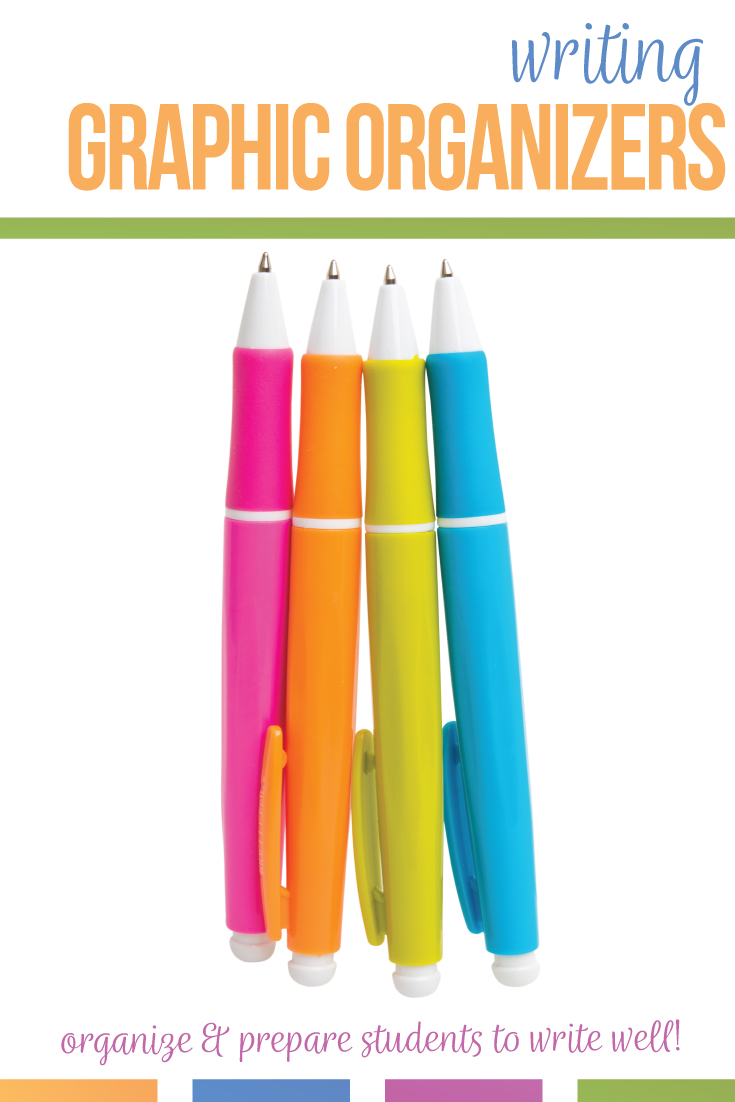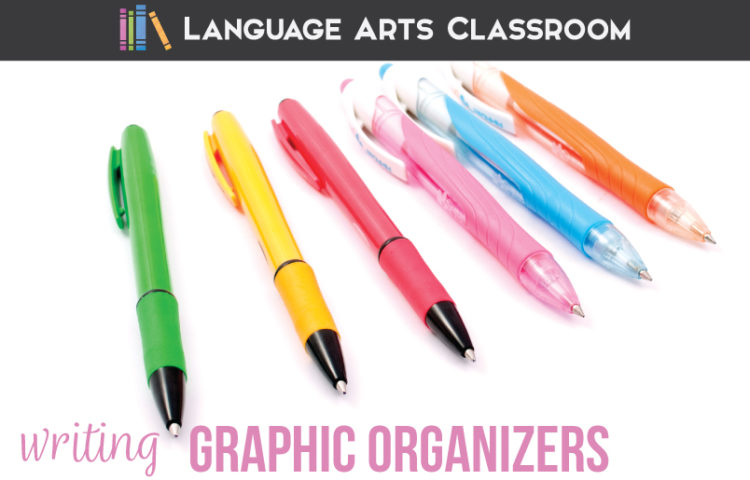Writing graphic organizers are lifesavers with my students. A graphic organizer for brainstorming, for creative writing, and for grammar can help young writers.
Some students sit and write a paper. Other students need a bit of guidance. Another part of the class will enjoy writing papers. Normally, those students know how to outline or know how to accomplish their goals.
This post is not about those students. If you have students who struggle with brainstorming ideas, visualizing the end result, and worry about their writing, graphic organizers will help them.
I’m going to explain how I create them (and you can too!), why I scaffold them, and where I’ve seen growth.

Writing Graphic Organizers
Setting expectations
I use numerous rubrics, but overall, the traits of writing cover expectations for papers. Before we begin researching or brainstorming, I outline the traits of writing with my students. Doing so sets the foundation, and I sharing my goals with my students sets the attitude for our collaborative work.
Brainstorming
A graphic organizer for brainstorming helps almost all students. I stress brainstorming because the more ideas students understand, the richer their papers become. I provide student choice and guide students in choosing how to brainstorm. For students who simply do not know what to write, I use a basic web. I ask those students to think of every idea, and then I sit with them to guide connections and understanding.
When students are torn between two topics, I give them a graphic organizer with “option one” and “option two.” Both boxes then contain other smaller boxes for main points. I ask students to complete it and then show it to me or a friend. Simply the act of verbalizing both options typically helps students decide.
I scaffold the brainstorming even more. Once students have their main idea, they can then break down possible areas of support (which will become body paragraphs). I have drawn a tree and written the main idea on the trunk and written supporting ideas on the leaves. Other times, I give students boxes, and they must separate each main idea in a box. Both visuals provide ways for students to be sure:
- They are not repeating ideas.
- They have enough ideas to support the claim.
- They feel passionate about the paper.
Introduction
Throughout the entire writing process, I strive to give students choice. With the introduction, I ask them if they want to be on the serious side or on the abstract side.
For the serious type of questions, I will ask:
- At the end of your introduction, readers want to read more because…
- What tone best describes my introduction?
These types of questions shape students’ ideas about how to write an introduction. Students may not consider their tone before writing the paper, but when they have that idea planted, that knowledge shapes the rest of their paper.
Other times, students prefer to be a bit more creative, maybe abstract. Specifically, a creative writing graphic organizer can encourage fun and creativity. I will ask them about their introductions:
- What instrument announces my paper? A trumpet or a harp? (Then ask students why, and help them draw conclusions.)
- My introduction is like a welcoming front porch because…
Students not only have fun answering these questions, but the odd thinking forces them to look at their introductions in unusual angles. Plus, the class discussions often excel with abstract questions, and the writing of the introductions becomes more of a collaborative effort.
Later, if students dislikes their introduction, I will give them the other introduction graphic organizer (different from what they had at the start) to help them spruce and change the introduction.
Writing
Once we have organized our papers, we write. Throughout the writing process though, I do again provide graphic organizers where necessary.
Sometimes, students do not develop their voices until they are much older. Students might struggle conveying their message because of their voice. When that occurs, I ask students to think of what their voice should convey: trustworthiness, uniqueness, etc. Then, I ask students to support that voice with a sentence from their paper. (They will have a sentence for each trait. Oftentimes, the point is that students begin to think of the impact of their words.)
We look at each sentence and discuss how that sentence conveys the message. We look at verbs and subjects and question if there is room for improvement regarding word choice. Sometimes, students do not have a sentence that conveys the voice they want their audience to pick up on. We work on fixing that aspect.
Another area for improvement concerns strong sentences. Students might have a general dislike of their paper, and oftentimes, they need to tighten or spruce their sentences. Break down a sentence with them so that they can then find areas for improvement. For instance, ask students to write the sentence and then:
- Write three verbs to improve the sentence
- Write three adverbs about the verb
- Where three conjunctions (ones that will encourage sentence variety!)
- Write three adjectives about the subject
Put the sentence back together. Of course students will not use all of those components! However, they did learn that words matter and can apply those ideas to other sentences.
Conclusion
Similar to the introduction, I ask students if they would prefer an abstract or serious conclusion brainstorming sheet.
For the serious type of questions, I will ask:
- What was an important idea I shared?
- To what idea do I have an emotional connection?
Really get students thinking away from rewriting their introduction. Ask them, “now what?” You wrote this paper, and you want your reader to leave with an impactful statement. How can you best do that?
Other times, students prefer to be a bit more creative with conclusions. I will ask them:
- If a song played at the end of my paper, it would be…
- Who should do the voice-over for my conclusion?
Honestly, students will talk and examine why they answered those questions the way they did. Those lighter questions also allow you to tie the previous work on voice to the conclusion.
You can make graphic organizers with images from the web for your personal classroom. Add the images in a Google Doc. Insert squares or other images in Slides. Move the images and add directions for your students.
Writing Growth
The largest growth area? Students are less frustrated and show more confidence. When we brainstorm before beginning, when we discuss expectations and define the traits of writing, students have better attitudes toward writing. They are also more likely to participate in revision activities.
Graphic organizers can help any writer, but they can be lifesavers for anxious or struggling writers. Students crave various approaches, and I aim to give them unique and scaffolded ones.
I hope this post inspires you in your lesson planning and classroom creations. You can also look at my writing graphic organizers.


